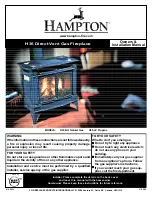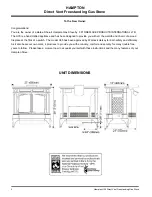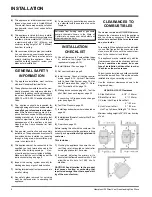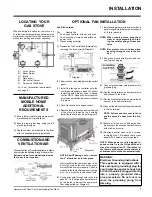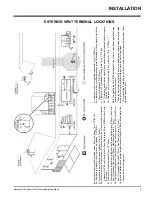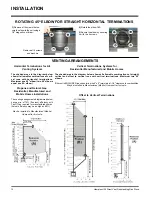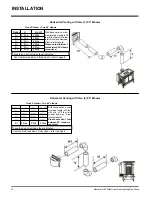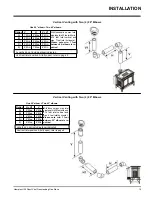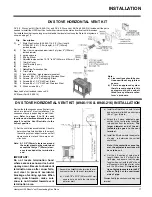
8
Hampton H35 Direct Vent Freestanding Gas Stove
INSTALLATION
INSTALLATION
PRECAUTIONS
These venting systems are engineered prod-
ucts that have been designed and tested for
use with the H35-NG, and H35-LP. The warran-
ty will be voided and serious fire, health or other
safety hazards may result from any of the
following actions:
1)
Installation of any damaged Direct Vent
component
2)
Unauthorized modification of the Direct Vent
System
3)
Installation of any component part not man-
ufactured or approved by Simpson Dura-
Vent or FPI Fireplace Products International
Ltd.
4)
Installation other than as instructed by Simp-
son Dura-Vent and FPI Fireplace Products
International Ltd.
Warning: Always maintain required
clearances (air spaces) to nearby
combustibles to prevent a fire haz-
ard. Do not fill air spaces with insu-
lation.
Be sure to check the vent termination clearance
requirements from decks, windows, soffits,
gas regulators, air supply inlets and public
walkways as specified in the Exterior Vent
Terminal Locations on page 9 and in your local
building codes.
The gas appliance and vent system must
be vented directly to the outside of the
building, and never be attached to a chim-
ney serving a separate solid fuel or gas-
burning appliance.
Each direct vent gas
appliance must use it's own separate vent
system. Common vent systems are prohibited.
SAFETY
PRECAUTIONS FOR
THE INSTALLER
1)
Wear gloves and safety glasses for pro-
tection.
2)
Exercise extreme caution when using lad-
ders or on roof tops.
3)
Be aware of electrical wiring locations in
walls and ceilings.
VENTING
INTRODUCTION
The Horizontal Termination Kit and the Simpson
Dura-Vent Direct Vent System Model DV-GS
venting systems, in combination with the Direct
Vent Freestanding Gas Stoves, H35-NG, and
H35-LP, have been tested and listed as direct
vent heater systems by Warnock Hersey.
These units use the "balanced flue" technology
Co-Axial system. The inner liner vents products
of combustion to the outside while the outer
pipe draws outside combustion air into the
combustion chamber thereby eliminating the
need to use heated room air for combustion and
losing warm room air up the chimney.
Note: These flue pipes must not be
connected to any other appliance.
The gas appliance and vent system must be
vented directly to the outside of the building, and
never be attached to a chimney serving a
separate solid fuel or gas burning appliance.
Each direct vent gas appliance must use it's
own separate vent system. Common vent sys-
tems are prohibited.
IMPORTANT
Read all instructions carefully before starting
the installation. Failure to follow these instruc-
tions may create a fire or other safety hazard,
and will void the warranty. Be sure to check the
venting and clearance to combustible require-
ments. Consult your local building codes
before beginning installation.
The location of the termination cap must con-
form to the requirements in the Exterior Vent
Terminal Locations on page 9.
VENT RESTRICTOR
POSITION
To set the Vent restriction as indicated in the
Venting Arrangement diagrams on pages 16-
20, simply loosen the screws and push the vent
restrictor plate to the correct position. Tighten
the screws.
Horizontal Termination:
Vent Restrictor setting at 36,000 Btu/h
Vertical Termination:
Vent Restrictor setting at 36,000 Btu/h

